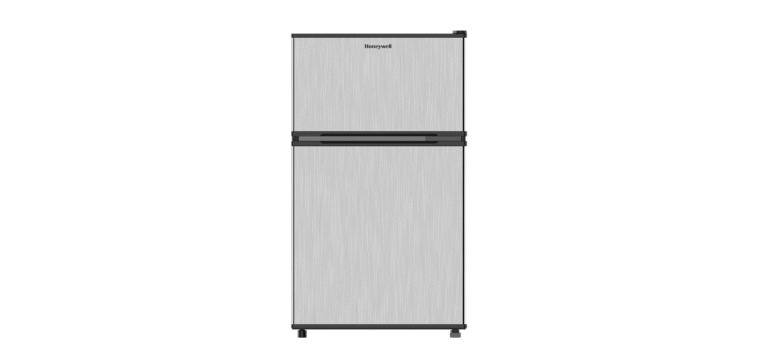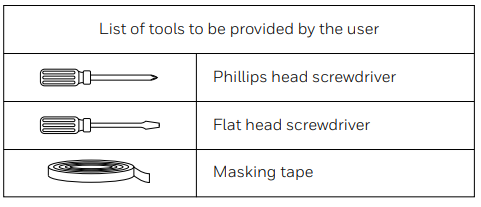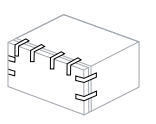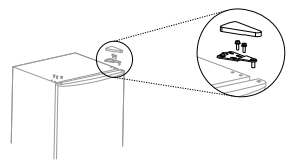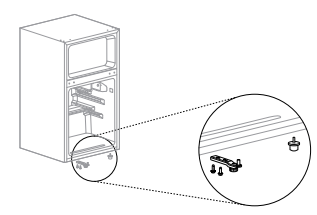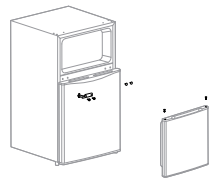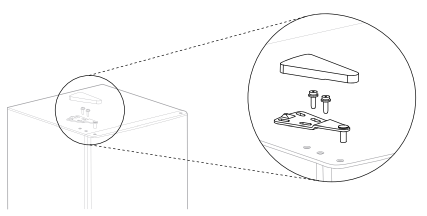Honeywell H31MRS 2 Door Compact Refrigerator
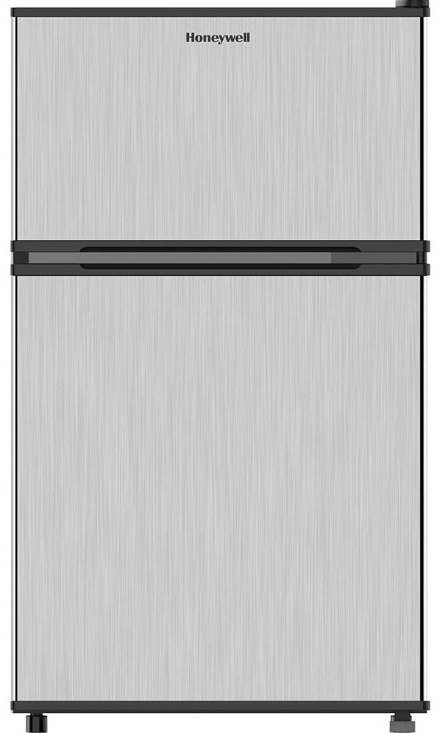
Safety Instructions
- DO NOT store explosive substances such as aerosol cans in this appliance.
- DO NOT use extension cords or ungrounded two-pronged) adapters.
- Keep ventilation openings in the appliance enclosure or the built-in structure clear of obstruction.
- Do not use mechanical devices or other means to accelerate the defrosting process, other than those recommended by the manufacturer.
- Do not damage the refrigerant circuit.
- Do not pull the power cord when unplugging the refrigerator. Please firmly grasp the plug and pull it out of the socket directly.
- Replace worn or damaged power cords in manufacturer-authorized maintenance stations.
- In case of a gas leak, please turn off the valve of the leaking gas and then open the doors and windows. Do not unplug the refrigerator and other electrical appliances since that spark may cause a fire.
- To ensure safety, it is not recommended to place regulators, rice cookers, microwave ovens, and other appliances on the top of the refrigerator, unless recommended by the manufacturer.
PROPER USE OF REFRIGERATOR
Placement
- Before using the refrigerator, remove all packaging material, including bottom cushions, foam pads, and tape inside, and tear off the protective film on the door and the refrigerator body.
- The refrigerator should be placed in a well-ventilated indoor place on ground that is flat and sturdy surface.
- Keep away from heat and avoid direct sunlight. Do not place the refrigerator in moist or watery places to prevent rust or reduction of insulation.
- Please leave at least 30 cm of space above the refrigerator, and 10 cm from both sides and the backside to facilitate heat dissipation.
Precautions before installation
To prevent possible injury, before installing or adjusting accessories, ensure that the refrigerator is disconnected from power.
Leveling Feet
Schematic diagram of the leveling feet
Adjusting procedures
- Turn the feet clockwise to raise the refrigerator.
- Turn the feet counterclockwise to lower the refrigerator.
- Adjust the right and left feet based on the procedures above to a horizontal level.
Reversing the Door Swing
- Remove all food from door shelves. Fix the door with tape.

- Dismantle the top hinge cover, the top hinge, and the hole cap of the other side.

- Remove the freezer door as well as the middle hinge and the hole cap of the other side.;

- Exchange the installation position of the bottom Honeywell H31MRS 2 Door Compact Refrigerator hinge and the adjustable foot, then fix them respectively. Remove the hinge sleeve pipe of the refrigerating door, and install it on the other side. Remove the hinge sleeve pipe of the freezer door and install it on the other side.

- Place the refrigerator door on the bottom hinge, then fix the middle hinge on the left side and insert the hole caps on the right side.

- Place the freezer door on the middle hinge, then Honeywell H31MRS 2 Door Compact Refrigerator fix the top hinge, the top hinge cover on the left side, and insert the hole caps on the right side.

Changing the Light
Disconnect the power supply before replacing the bulb; hold and remove the light bulb cover. Remove the old bulb by unscrewing it counterclockwise. Reassemble the light cover and reconnect your freezer to the power supply.ply
Starting to use
- The refrigerator must stand upright for two hours before connecting power when it is first started.
- Run the refrigerator for 2 to 3 hours, or 4+ hours in the summer, before loading fresh or frozen food.
Energy Saving Tips
- The appliance should be located in the coolest area of the room, away from heat-producing appliances or heating ducts, and out of the direct sunlight.
- Let hot foods cool to room temperature before placing them in the appliance. Overloading the appliance forces the compressor to run longer. Food that freezes too slowly may lose quality or spoil.
- Be sure to wrap food properly, and wipe containers dry before placing them in the appliance to cut down frost build-up inside the appliance.
- Do not line the storage bin with aluminum foil, wax paper, or paper towels. Liners interfere with cold air circulation, making the appliance less efficient.
- Organize and label food to reduce door openings and extended searches. Remove as many items as needed at one time, and close the door as soon as possible.
STRUCTURE AND FUNCTIONS
Key Components
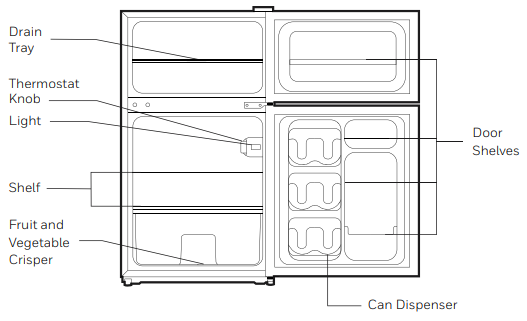
Refrigerator
- The refrigerator is suitable for storing a variety of fresh foods to be consumed within the short term. Suggested storage time is 3 to 5 days.
- Cooked food should be cooled to room temperature before being placed into the refrigerator.
- Glass shelves may be adjusted up or down for easy use or additional storage space.
Freezer
- The low temperature of the freezer may keep food fresh for a long time, and it is mainly used to store frozen foods and to make ice.
- The freezer is suitable for the storage of meat, fish, shrimp, pastries, and other foods not to be consumed in the short term.
- Chunks of meat are preferably divided into small pieces for easy access. Please note that food should be consumed within its shelf life.
Temperature Control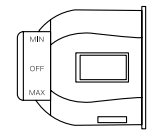
The markings on the control knob indicate the “MIN, MAX, and OFF” for the different temperature levels. “MAX.” lowers the internal temperature of the refrigerator; “MIN.” increases the internal temperature of the refrigerator; Recommended gear: “Mid-range”
MAINTENANCE OF REFRIGERATOR
Cleaning
- Clean the dust behind the refrigerator and on the ground to improve the cooling effect and energy saving.
- Check the door gasket regularly to make sure there is no debris. Clean the door gasket with a soft cloth dampened with soapy water or diluted detergent.
- Clean the interior of the refrigerator regularly to avoid odor.
- Please turn off the power before cleaning the interior, and remove all food, shelves, drawers, etc.
- Use a soft cloth or sponge to clean the inside of the refrigerator, with two tablespoons of baking soda and a quart of warm water. Then rinse with water and wipe clean. After cleaning, open the door and let it dry naturally before turning on the power.
- Do not use soap, detergent, scrub powder, spray cleaner, etc., as these may cause odors in the interior of the refrigerator or contaminate food.
- Clean the bottle frame, shelves, and drawers with a soft cloth dampened with soapy water or diluted detergent. Dry with a soft cloth or dry naturally.
Defrost
Power off the refrigerator and disconnect the plug from the wall socket. Open the door and remove all the food to a cool place. Clean the drain pipe, paying special attention to cleaning the compressor compartment water draining tray to avoid water overflowing onto the ground. It is recommended to remove the frost with a plastic scraper or let the temperature rise naturally until the frost melts. Then wipe away the remaining ice and water, and plug in the freezer. After defrosting, put all food back into the refrigerator, and power on.
Stop Using
- Long-time nonuse: Please unplug the unused refrigerator for cleaning. Keep the door open to avoid odor.
- Moving: Do not turn upside down or shake the refrigerator; the carrying angle can not be greater than 45°.
- Do not hold the door or hinge when moving this unit.
Continuous operation is recommended when the refrigerator is started. To prevent affecting the refrigerator’s service life, please do not stop the refrigerator under normal circumstances.
TROUBLESHOOTING
| Inoperation | Ensure the refrigerator is plugged in and connected to power Check that the voltage is not low
The temperature control knob is not set to “OFF“ |
| Odor | Thoroughly clean the interior of the refrigerator. |
| Long-term operation of the compressor | Do not overload the refrigerator Do not put hot contents in the refrigerator
Note that it is normal for the refrigerator to operate for a longer time in summer when the ambient temperature is higher. |
| The light is out | Check whether the refrigerator is connected to the power supply. |
| Doors cannot be properly closed. | Check for any items blocking the refrigerator door or unbalanced items.
Check if the refrigerator is tilted. |
| Loud noise | Ensure that the refrigerator is sitting on a flat and stable surface.
Ensure that the refrigerator accessories are properly placed |
| The door seal fails to be tight | Remove foreign matter from the door seal.
Heat the door seal and then cool it for restoration (or use an electrical drier or a hot towel for heating). |
| The water pan overflows | Heavy defrosting may occur when there is too much food in the refrigerator or if the food contains too much water. Frosting may occur if the doors are not properly closed, as entry of air could cause frosting, which could increase water overflow during defrost. |
| Hot housing | Heat dissipation of the built-in condenser via the housing is normal.
When housing becomes hot due to high ambient temperature or storage of too much food, provide ventilation to facilitate heat dissipation. |
CONTACT
If your product needs repair, please contact us via email or phone.
- Customer Service Tel: 1-800-604-0295
- Customer Service Email: support@honeywellcoolingappliances.com
- Website: honeywellcoolingappliances.com


